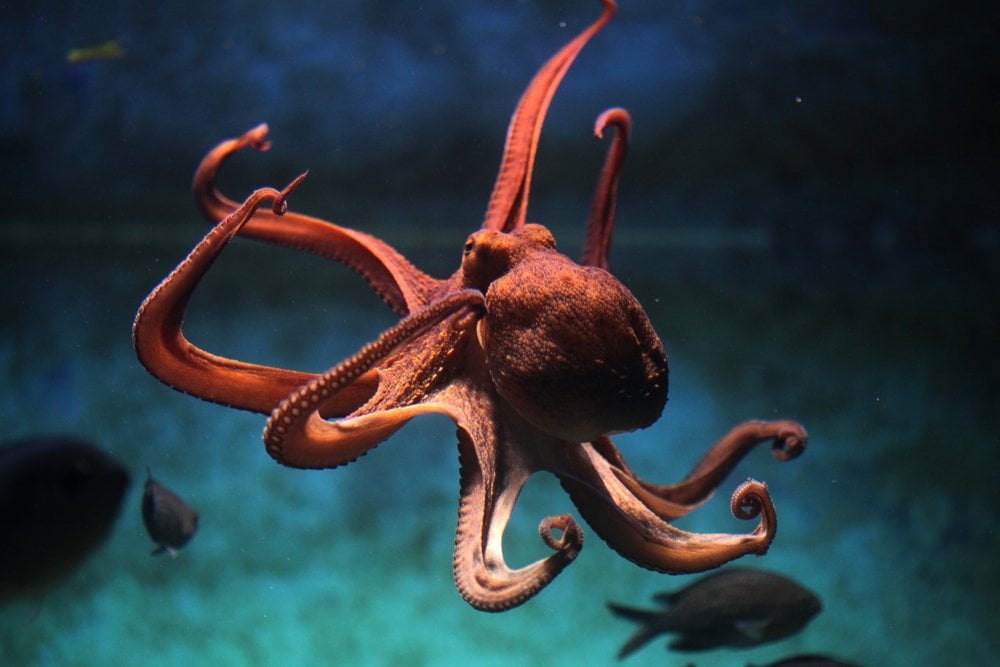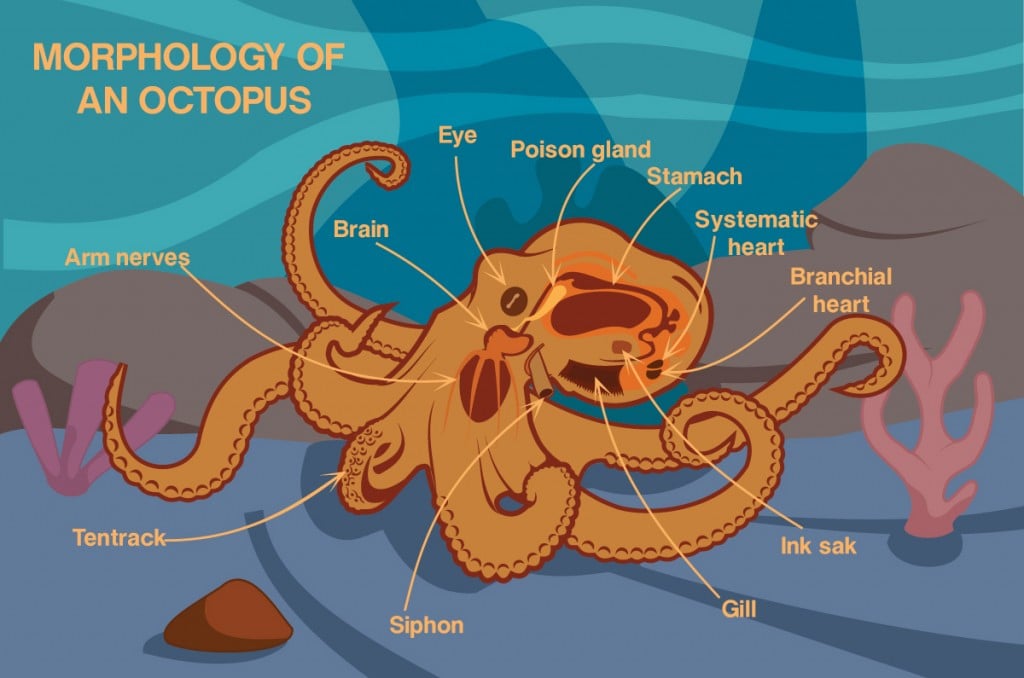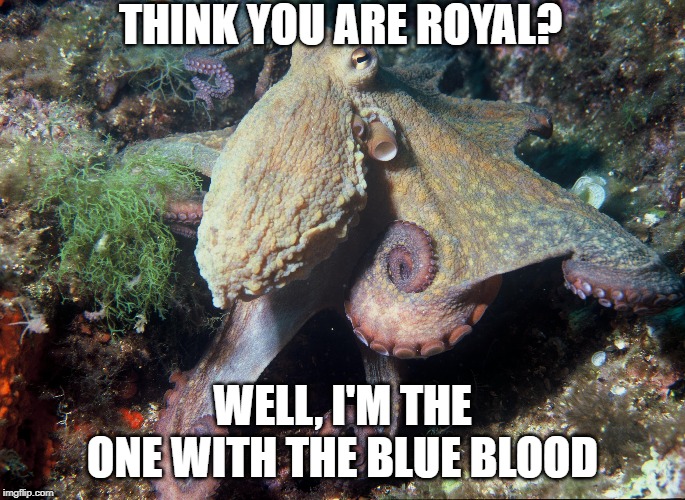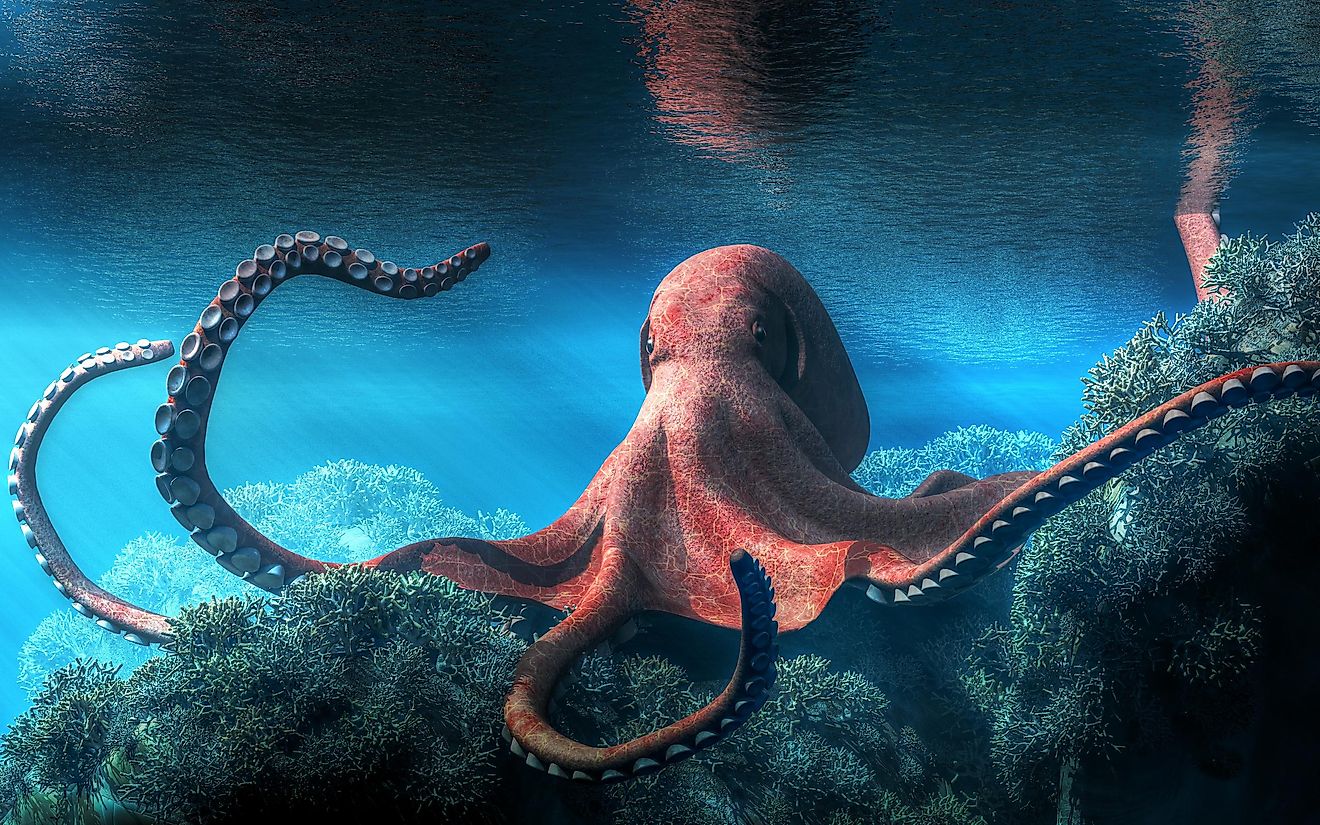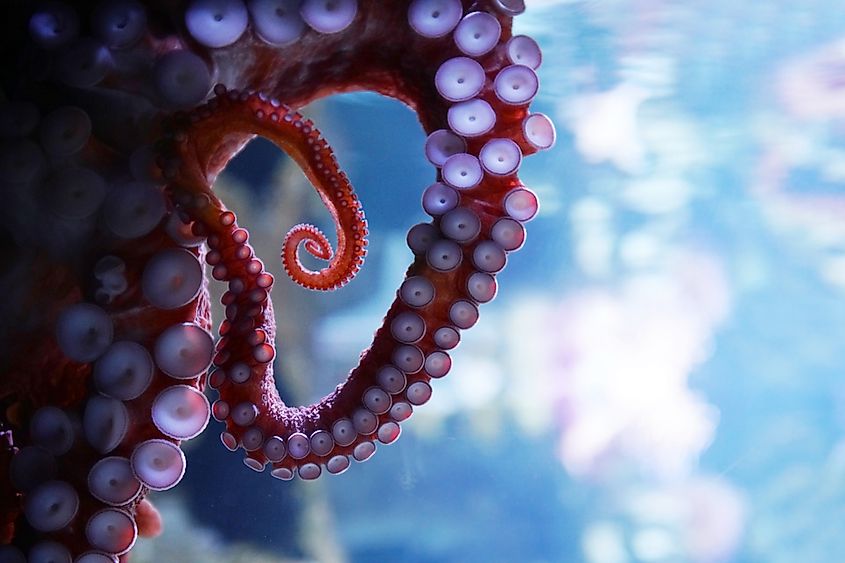How many hearts does an octopus have
How many hearts does an octopus have
How many hearts does an octopus have?
Octopus vulgaris, Eastern Atlantic, Galicia, Spain
Octopuses have three hearts, which is partly a consequence of having blue blood. Their two peripheral hearts pump blood through the gills, where it picks up oxygen. A central heart then circulates the oxygenated blood to the rest of the body to provide energy for organs and muscles.
Octopuses are cephalopods, which literally means “head foot”, describing their truncated anatomy. Like the three other members of the group – squids, cuttlefish and nautiluses – they have blue blood, because it uses a copper-rich protein to transport oxygen. This helps explain why they need three hearts.
Our red blood gets its colour from an iron-based protein called haemoglobin, which is carried in red blood cells. Cephalopods use a copper-based protein called haemocyanin, which is much larger and circulates in the blood plasma. Haemocyanin is less efficient at binding with oxygen than is haemoglobin. However, octopuses compensate for this by having three hearts – two “branchial” hearts, which receive deoxygenated blood from around the body and pump it through the gills, and one “systemic” heart, which takes that oxygen-rich blood, increases its pressure and then circulates it around the rest of the body.
One clue that the three-heart system is needed to help power an octopus’s active lifestyle comes from the other cephalopods. The only member of the group not to share this anatomical anomaly is the nautilus, which is more sedentary and energy-efficient than the others. What’s more, octopuses may be particularly reliant on good circulation of oxygenated blood to power their extensive nervous system. Octopuses have nine brains: a central brain between their eyes and a mini one in each arm. This brain tissue is notoriously fuel intensive.
Advertisement
Of course, octopuses also need oxygen to power their muscles. Their preferred mode of locomotion is to crawl along the seabed. They can also swim at high speeds, propelled by jets of water, which they shoot out of a tube called a siphon. However, when they are swimming, the systemic heart does not beat, so they tire easily.
There are some 300 species of octopus, ranging in size from the giant Pacific octopus, which can weigh 50 kilograms, to the tiny Octopus wolfi, at less than a gram.
Almost all octopuses are solitary. They live in a wide range of habitats from intertidal zones to deep water, and this is where having blue blood may be advantageous. Haemocyanin seems to help octopuses transport oxygen efficiently in environments that vary widely in temperature and oxygen levels. It is particularly efficient in the cold ocean, which is a boon for species like the Antarctic octopus. However, haemocyanin loses its ability to bind to oxygen as acidity increases. That doesn’t bode well for octopuses as climate change makes oceans warmer and more acidic.
Why Do Octopuses Have Three Hearts?
Octopuses have three hearts because they transport oxygen using hemocyanin, which is less efficient than hemoglobin at transporting oxygen.
We have a single powerful heart pumping blood throughout our entire body. Most other mammals and animals have a single heart that circulates oxygen and nutrients throughout the body. All these single hearts might not look or function the same, but they get the job done.
Now meet the cephalopods—the squid, octopuses, and cuttlefish (also nautiloids, but we’ll come to them later) living in the sea. They weren’t happy with just one heart, so they went and evolved themselves three. Their three hearts together serve to pump blood throughout their flexible and mostly boneless body to supply oxygen.
Why do they need three hearts instead of the single heart that works for so many others in the animal kingdom?
Octopuses are cephalopods. (Photo Credit : Vladimir Wrangel/Shutterstock)
Recommended Video for you:
How Octopuses Circulate Their Blood
Cephalopods have a closed circulatory system, the only class in the phylum Mollusks that do (this is the same phylum to which snails and clams belong). A closed circulatory system means that their blood flows within vessels, unlike an open circulatory system, where all the blood or hemolymph bathes all the tissues, such as is found in insects, prawns and other mollusks.
The three hearts in cephalopod circulation have different functions. There is the main heart, like our one human heart, called the systemic heart that pumps the blood throughout the body. The other two hearts are the branchial hearts or the gill hearts, located near each gill. All these structures are in the mantle, a muscular structure right behind the head of the cephalopod. The mantle also houses other organs, such as the digestive system and reproductive glands.
(Photo Credit : Jayjune69/Shutterstock)
The actual movement of the blood through the three hearts isn’t that unusual. The deoxygenated blood returns to the systemic heart from the rest of the body. The systemic heart reroutes this blood to the branchial hearts. The branchial hearts then send the blood to capillaries in the gills to get oxygenated. This oxygenated blood is sent back to the systemic heart, at which point it makes its way to the rest of the body to replenish its tissues with oxygen. And so, the process repeats itself.
Other animals have a similar system set up, but instead of two more hearts, blood is sent directly to the lungs or gills to get its oxygen. Humans have the pulmonary artery arising from our heart, which takes deoxygenated blood to the lungs to get oxygenated. The pulmonary vein brings oxygen-rich blood back to the heart for distribution.
The reason cephalopods take the three-heart route, rather than the direct route, might have to do with their blood.
Octopus’s blood is the reason for its 3 hearts
We might call royalty ‘blue-blooded’, but the true ‘blue bloods’ are the cephalopods. Unlike our blood, which is red due to our iron-containing oxygen transporter hemoglobin, the cephalopods use a copper-containing protein called hemocyanin. The hemocyanin, when bound to oxygen, gives their blood a blue color.
When the protein isn’t bound to oxygen, it turns transparent! You won’t see this transparent deoxygenated blood because on contact with oxygen in the water or in the atmosphere, the blood with turn blue again.
Hemocyanin is the oxygen transporter in cephalopods. It is blue when it is oxygenated and colorless in the deoxygenated state.
Hemocyanin isn’t as efficient at transporting oxygen as hemoglobin. Hemocyanin’s copper binds to oxygen non-cooperatively, whereas hemoglobin’s iron binds to oxygen cooperatively.
Furthermore, when hemoglobin is partially oxygenated, due to conformation changes in the protein, its affinity to oxygen increases further.
However, hemoglobin isn’t great at low temperatures, where more early cephalopods resided. In these low temperature, low-oxygen pressure environments, hemocyanin had the upper hand.
Hemocyanin, unlike hemoglobin, which is present within red blood cells, is a free-floating protein complex within cephalopod blood, which makes their blood more viscous. Not being inside a cell might aid in its oxygen transport capabilities at low temperatures.
To compensate for the otherwise lowered oxygen transport efficiency and increased viscosity, cephalopods needed to circulate their blood at higher pressures. The solution was developing three hearts. Over years, octopuses and squids ascended to warmer shores, making their three hearts pumping blood at a higher pressure very important.
All of that being said, not all creatures that have blue blood need three hearts. The cephalopod nautilus, the mesmerizing spiral-shelled marine animal, only has a single heart that pumps blood, unlike its three-hearted relatives. It probably doesn’t need the two extra hearts because of their relatively smaller size and the creature’s very sedentary lifestyle.
Arthropods like the famous horseshoe crab and some scorpions also have blue hemocyanin blood. The arthropod hemocyanin differs from molluscan hemocyanin in structure and protein subunits. The arthropods might not have evolved three hearts because with their open circulatory system, they didn’t need three hearts.
Evolution pulled a weird trick with this one.
Conclusion
Even with these three hearts, octopuses and squids can’t bolt around carefree. In fact, octopuses prefer a more laid back lifestyle because their systemic heart cannot take an intense cardio workout.
When an octopus has to swim fast to catch prey, its systemic heart will tire and stop after a while forcing the octopus to stop and recover. This is why you probably won’t see an octopus actively zooming about in the ocean. To preserve energy and not tire out their heart, they prefer to scurry and crawl on the ocean floor, always moving, always watching.
The late Dr Martin Wells, cephalopod researcher, enthusiast and beloved teacher, once said that the octopus is an alien. Well, with three hearts, blue blood, and those oddly sentient-looking eyes, they might as well be!
Alien or not, we love them in all their zany glory!
How Many Hearts Does An Octopus Have?
An octopus with an almost red and pink marbled skin moves among brown coral in an ocean shallow.
The Anatomy Of An Octopus
The octopus is a mollusk with eight limbs and a soft body. It is grouped with cuttlefish, squids, and nautiloids in the class Cephalopoda. It shares similar characteristics with the other cephalopods, meaning it has two eyes and a beak, and its mouth is placed at the center of its eight limbs. The term ‘tentacles’ is often used when talking about octopuses. However, it is not the correct term. Tentacle signifies appendages used for feeding, and the octopus doesn’t use its limbs to feed.
Octopuses have a soft body that can change shape allowing passage through small gaps underwater. While swimming, their eight limbs trail behind them, and they use their siphon to expel a jet of water that propels them forward. They also have an intricate nervous system and exceptional sight. Octopuses have three hearts, one that circulates the blood throughout the entire body and two, which drive blood through the two gills.
Close up on live octopus in the aquarium.
The former is called the systemic heart, while the latter two are known as branchial hearts. The systemic heart is dormant, while the octopus is swimming. The blood of an octopus is very sticky, so it requires high blood pressure for it to be pumped around the body. The blood vessels of an octopus are much different than those found in other invertebrates. Its veins are lined with cellular endothelium, which is unique to that species.
The Distribution And Life Of Octopuses
Octopuses can be found in very different parts of the ocean. Some of those include coral reefs and the seabed. Some octopuses inhabit the abyssal depths of the ocean, while others can be found in the intertidal area. There are no species of octopus that are living in freshwater regions. They exhibit different strategies to defend themselves from predators. They can use the discharge of ink, camouflage, or run away very quickly and hide. While octopuses are venomous, they are not deadly to humans, save for the blue-ringed octopus. Most octopus species live a solitary life except for the times when they are mating.
Octopuses are predatory animals, and they eat a lot of smaller creatures that inhabit the deep sea. They are extremely intelligent, to an extent we’re still not familiar with completely. They are known to solve labyrinth puzzles, which proves they have a memory system. They can also be trained to differentiate between shapes and designs.
They grow surprisingly quickly, and their lifespans are short. After mating, the male octopus dies, and once the eggs hatch, the female dies as well. Some octopus species only live for six months, while the longest living species have a lifespan of five years.
How Many Hearts Does an Octopus Have?
The octopus is one of the world’s most alien creatures, but nothing puts that into perspective more than the physiological differences between them and the creatures we’re most familiar with. Like cockroaches and squid, the octopus’ neurology is controlled by multiple separate brains — nine in the case of this strange octopod. And plenty of their skills of manipulation come down to the fact that they can use those brains to control eight distinct tentacles. But their circulatory system is just as unusual. The octopus has multiple hearts, and that fact can reveal secrets about their evolutionary history while also informing our understanding of how they manipulate their environments. Here are all the facts you need to know about an octopus’ hearts.
How the Heart Works
Not every animal has a heart. Sea anemones and starfish both get by without a dedicated organ for pumping blood — but the fact that the jellyfish is the largest animal without a heart is an indication of the necessity of a heart for animals that are physiologically sophisticated beyond a certain level. The notion of a circulatory system driven by a centralized pump that can deliver blood throughout the body first evolved approximately 600 million years ago, and it’s since been a staple of almost all animal life. Regardless of whether you’re discussing a bald eagle, a tree frog, or a bumblebee, the function is the same — delivering nutrients and oxygen to nourish the body’s tissues and disposing of any waste in circulation.
Most animals have a single heart, but even those can vary significantly in terms of design and functionality. The aforementioned bumblebee has an open circulatory system with a heart that runs the length of the body and simply spills blood over the organs. The exceedingly long neck of Africa‘s giraffe requires these equines to possess incredibly powerful hearts with thick cardiac walls that are capable of pumping blood efficiently all the way to their brains. The world’s fastest land mammal — the cheetah — also has an incredibly fast heart, and one capable of exceptional acceleration. Scientific facts indicate it can double its resting heart rate of around 120 BPM over the course of a few seconds.
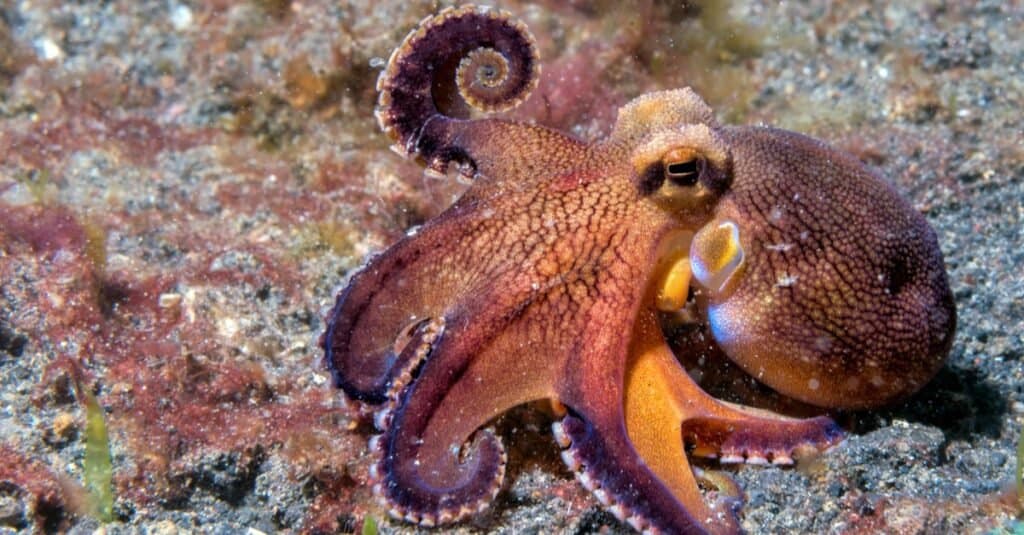
Why Some Animals Have Multiple Hearts
Tracing an evolutionary tree backward can be difficult. Animals in a family tree will sometimes lose traits that are generally defining features for their group — as is the case with dolphins losing their legs and retreating to life as aquatic mammals. But the facts of the matter are that there are no known mammals, reptiles, amphibians, or birds with multiple hearts. That suggests that the development of more than one heart pump happened far back up the evolutionary tree. It also suggests that these additional hearts developed out of a need to survive in extreme or alien environments, or else it would be likely to recur in more places. Understandably, most of the animals with multiple hearts appear rather alien to humans.
One of the most primitive and ubiquitous creatures with multiple hearts is the earthworm. The five hearts of this worm are more prototypes of a heart than the real thing, as they’re essentially just specialized blood vessels. Based on the known facts, there’s an argument to be made that cockroaches have 13 hearts — although some scientists argue that it instead possesses a single heart with 13 chambers. For hagfish, the poor quality of the water they live in necessitates a circulatory system that’s capable of filtration, and the result is a series of four hearts that can continue to operate for a full day and a half without oxygen. Both cuttlefish and squid possess three hearts, an evolution they also adapted to remediate the unique difficulties of the aquatic ecosystems they inhabit.
How Many Hearts Does an Octopus Have?
In fact, the circulatory systems of the squid and cuttlefish are functionally the same as the octopus — a revelation that comes down to the fact that they’re all related under the class Cephalopoda. Functionally, cephalopods share similar anatomy to survive in similar environments to one another. Cephalopoda actually translates to “head foot”, and they’re all composed of a head that serves as the anchor point for eight or more arms and a foot that helps them navigate in the water. The number and nature of these arms can vary depending on the animal, but octopus species are particularly well developed. Their eight tentacles are highly sensitive and capable of incredibly fine motor skills, and octopi have already developed nine brains. One central brain serves as central routing for eight separate brains that are each in charge of a different tentacle.
Similarly, octopi and other cephalopods have developed three hearts. All three of these hearts are located within the animal’s head, with the systematic heart serving as the primary circulatory pump and two branchial hearts assisting. This isn’t functionally that different from how the heart works in other creatures, although it does split up the duties. The two branchial hearts take pure blood rich in oxygen and pump it through the octopus’ gills so oxygen and nutrients can be distributed throughout the remote tissues in the body. Once this blood finishes its cycle, it will return to the systematic heart where it will be pressurized and sent back through the cycle.
The size and volume of an octopus’ extremities help partially explain why these cephalopods might need such a specialized circulatory system, but the high amounts of energy required to keep nine separate brains oxygenated could be a serious contributing factor as well. The nautilus is the only cephalopod to not have three hearts, and it’s both physiologically less complex and significantly more sedentary than both the squid and the octopus. But just because this unique three-pump design developed out of evolutionary necessity doesn’t mean that it’s perfectly efficient. Octopi have two primary modes of navigation — crawling along the surface of the sea bed and using their tentacles and current to propel itself forward. Octopi rely primarily on the former mode of navigation because their systematic heart actually stops working in the process. This inability to exert themselves for extended periods of time could have contributed to octopi developing ambush hunting methods and environmental camouflage as a primary defense mechanism.
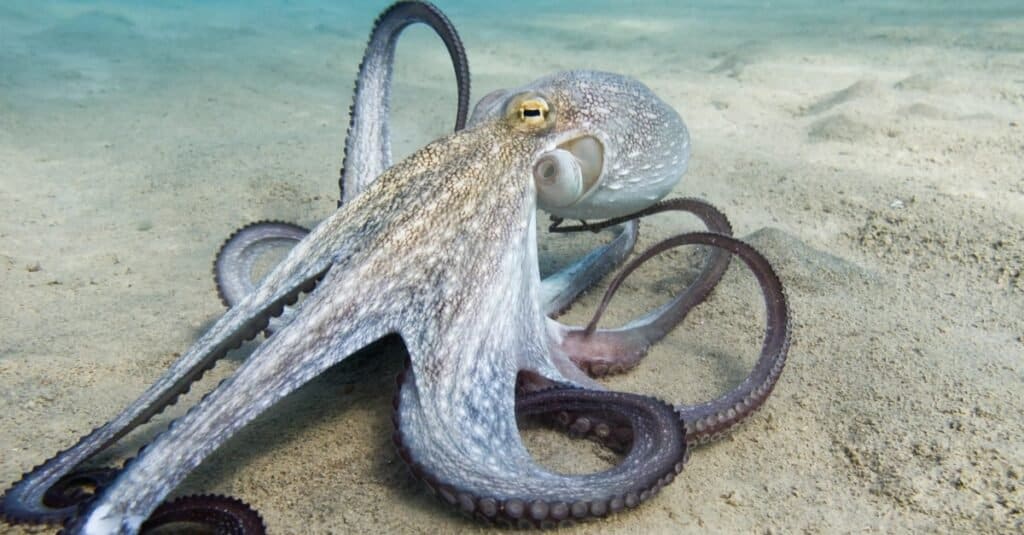
Why Do Octopuses Have Blue Blood?
The mystery behind an octopus’ blue blood is actually critical to understanding their need for three hearts. Human blood appears red when it leaves the body because of the presence of an iron-based protein called hemoglobin. Octopi instead use a protein derived from copper known as hemocyanin. Hemocyanin is the heavier of the two, and its unique chemical structure ensures that their blood appears blue when spilled. Octopi have proven very efficient at using all of the oxygen their hearts pump through their body, but that may be less a sign that they have efficient circulatory systems and more a result of necessity. Hemocyanin is only about a quarter as effective as hemoglobin at transporting oxygen, thus necessitating three separate hearts with two specialized for circulation and one for processing.
Studies into a species of octopus that appears in the frigid Antarctic could shed some light on why these animals developed such a seemingly inefficient protein in their blood composition. This species — the Pareledone charcoti — displays considerably higher concentrations of hemocyanin in its blood: roughly 40% more than any other observed octopus species. This doesn’t appear to be coincidental. Researchers believe that this physiological change is meant to help these octopi adapt to colder conditions where oxygen exchange rates are much less efficient. At the same time, these octopi were still able to adjust and even exceed their circulatory efficiency when they were placed in warmer waters.
Over 300 octopus species exist on the planet, and they’ve managed to carve out a niche in practically every major body of saltwater. The octopus’ high level of adaptability has allowed it to survive in extreme temperatures and environments, and their strangely inefficient heart could be to thank for that. It might even help octopi better weather the climate change to come.
How Many Hearts Octopus Have? Why do Octopus have 3 Hearts?

Well, that’s just one of the many amazing and popular “facts” about the octopus. It’s not true though, but the next wonder – the multiple hearts of the octopus, is a “fact”.
Table of Contents
Why do Octopuses have Three Hearts?
Octopuses have three hearts that work simultaneously to keep the octopus alive. That’s amazing, right? But why do they have three hearts, and do they really need all three – we humans, seem to do well enough with one heart?
Unlike humans and mammals that need only one heart, octopuses have three hearts because the copper-rich hemocyanin in their blood makes the blood thicker, this means that they need more pressure (and therefore more hearts) to pump the blood to and from their gills and around their body.
Although the octopus needs his three hearts in order to pump blood through his gills and around his body, the three hearts of the octopus do not all do the same thing.
Two of the hearts, called branchial hearts, are located near each of the octopus’ two gills. They pump blood through the gills of the octopus. The third heart (called the systemic heart), then pumps the oxygenated blood through the rest of the body.
Does an octopus need all three hearts to survive?
All three of the octopus’ heart are very important. Each heart of the octopus is not like a substitute or reserve heart. The three hearts actually work at the same time to pump blood through each the gills and around the body.
Regardless of this, the octopus does not need all three hearts to survive. It can live with less than all three of its hearts.
Can an Octopus Live with Two Hearts?
Exactly how many of the three hearts can an octopus survive on? Can an octopus survive if one heart is bad?
The answer depends on one which of the three hearts is not working. If one of these “branchial” hearts stops working, the octopus will still survive with two hearts.
Some people don’t think so however, they believe that since an octopus needs two hearts to pump blood through the gills, then if one fails, the octopus will not get enough oxygen-carrying blood and will eventually die.
It’s not necessarily true. Remember, the octopus has one heart near each of its two gills that pump blood through the gills.
The two gills are like human lungs, and when blood passes through them, the blood absorbs oxygen from the gills.
Even humans can survive on one lung. Add to this the fact that an octopus also absorbs oxygen through its thin skin. In fact, when resting, octopus get about 41% of their oxygen from their skin!
An octopus with two hearts may be a lot less active than normal, but it will survive. That said, if the octopus loses its systemic heart, which pumps blood around the body, it is as good as dead.
Can an Octopus Live with One Heart?
That is very doubtful. Losing two out of its three hearts means it has either lost both branchial hearts or one branchial heart and its main (systemic) heart. Losing both branchial hearts means the octopus cannot get blood through the gills to be oxygenated.
Losing one plus the main heart means the octopus may be able to pump blood through one heart and get it oxygenated, but then it wouldn’t be able to pump any blood to the rest of the body. An octopus would die if it lost two hearts, it cannot live with just one heart.
Purpose, Description & Size of each Heart in the Octopus
Let’s take a closer look at each of the hearts, what they do, and everything else we can learn about them.
1. The Two Branchial Hearts of the Octopus
An octopus has two hearts that are located right next to the two gills that it uses for respiration. The hearts are called branchial because they contract to pump blood up through the gills of the octopus. They are also called “gill hearts”.
An octopus needs these “accessory hearts” because unlike humans who’s heart have two sides that pump oxygen-rich blood to the lungs and then pump the now oxygen-rich blood throughout our bodies, the main heart of an octopus can only pump blood throughout the body. So, it needs “extra” hearts to pump blood through the gills for it.
How big are these “gill hearts”? There are about 300 species of octopuses all over the world. Some are so small you can hold them on your palm, like the Atlantic pygmy octopus. While others, like the giant Pacific octopus, can grow to about 16 feet. Because of this, the size of their hearts, are different for each type of octopus.
2. The Systemic Heart of the Octopus
The systemic heart of the octopus is the main heart of the octopus. It pumps oxygen-carrying blood around the body of the octopus. Like the gill hearts, its size depends on the species of octopus.
Can Some Octopuses Have More Than Three Hearts?
No, octopuses just have 3 hearts. Each heart carries out a specific function. (The gill hearts pump blood through the gills, while the systemic heart drives the blood throughout the rest of the body). So, any additional heart would be unnecessary.
Can Octopuses Have Eight Hearts?
Three hearts are a lot already. I’m not sure where an additional five hearts would fit in since an octopus has only enough room for just three hearts. So, no, an octopus cannot have eight hearts.
Octopus Heart Facts
Even though octopuses are very fascinating and more scientists are carrying out more research on them, there is still a lot we do not know about octopuses. But we do know a little about them. Here are some interesting things we found out.
Because an octopus has three hearts does not mean it loves three-times as much. They are quite solitary and when they do meet (almost at the end of their lifespan) to mate, it is often deadly for the male partner. The female may eat the male right after mating or the males develop “dementia” abandon their normal caution and die soon after.
Do Octopus Have Blood and What Color is their Blood?
Yes, octopuses have blood. So do other mollusks like snails, squids, cuttlefish, nautilus, and many others. The blood of an octopus is blue. Many invertebrates also have blue blood – and no, they’re not aliens 😉
Does an Octopus Bleed?
Short answer, yes! Since they have blue blood, if you were to cut an octopus or see an injured octopus, don’t be surprised if you see blue blood.
Why do Octopuses Have Blue Blood?
Octopuses have blue blood because the oxygen carrier in their bloodstream is hemocyanin. Hemocyanin is a copper-ion protein that carries oxygen around the bodies of invertebrate animals like the octopus. Unlike hemoglobin in humans, hemocyanin dissolves directly into the bloodstream of the octopus and this makes the blood blue.
You have hemoglobin which contains iron instead of copper. Because hemoglobin is an oxide of iron, it makes our blood red. Hemocyanin is a more efficient way for octopuses to transport oxygen in extremely low temperatures. This is why octopuses have hemocyanin instead of hemoglobin.
What Other Creatures & Animals Has Three Hearts?
Octopuses are not the only creatures with three hearts. Their closest relatives, squids, and cuttlefish also have three hearts. There are other animals that have even more hearts! The hagfish tops the list with four hearts and between five to fifteen pairs of gills.
The earthworm is sometimes listed as a multi-heart animal even though, the aortic arches of the earthworm are not technically hearts.
Related questions,Know More:
I’ve included answers to a few of the popular questions you might have heard about octopuses, check them out.
How Many Brains Does an Octopus Have?
Contrary to popular opinion, Octopuses only have one large brain. But they also have about two-thirds of their neurons distributed in their arms, people sometimes get confused and refer to the neuron bundles as “brain”. That’s why you tend to see articles like this one claiming that octopuses have nine brains.
The bundles of neurons are highly specialized, however, and independently control the movement of each arm, taste, and feel objects freeing up the main brain to focus on other activities.
How Many Stomachs Does an Octopus Have?
Octopuses have only one stomach. Despite their having multiple everything – or almost everything, these intelligent cephalopods do not seem to want an extra stomach.
How Many Tentacles Does an Octopus Have?
An octopus does not have any tentacle. It only has eight arms. People who are similarly confused by the squid also claim it has ten tentacles. A squid has eight arms and two tentacles. What’s the difference?
There are two main ways to tell the difference between tentacles and arms. The first is that tentacles can be retracted, while arms remain at the same length even though they can be folded.
The second way of telling the difference is that arms have suckers along their whole length, while tentacles only have suckers at the tips.
There you have it, everything about the amazing and weird octopus and there’s still a lot more we don’t even know.
Even at that, scientists are already studying some of the bizarre characteristics of octopuses to see how or if we can adapt their techniques to build everything from robots to 3D mimicking artificial skins.

